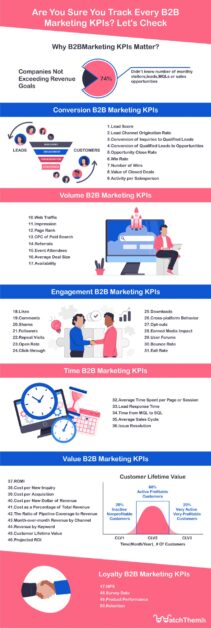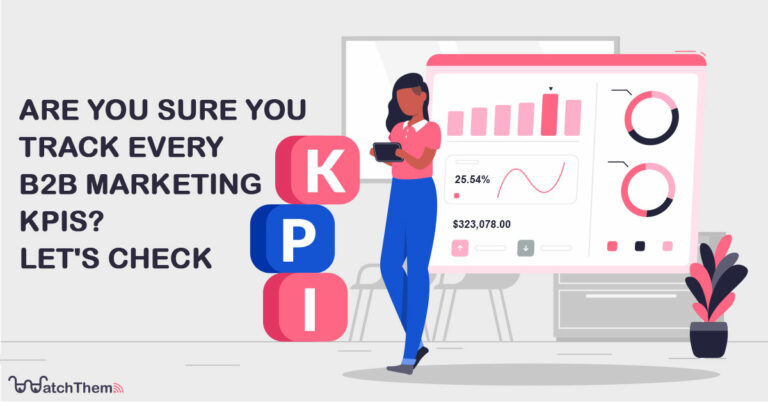Page Contents
B2B marketing KPIs should be measured to understand how effective your B2B strategies are, and what needs change. Keep an eye on your B2B marketing metrics to ensure your marketing efforts are in line with your business targets.
KPIs or Key Performance Indicators are measurable and evaluated data compared to a specific target or goal. Some online B2B marketing KPIs include website traffic, landing page testing, and conversion rate, to name a few. These measures can help businesses in making data-driven decisions and boost performance.
Why B2B Marketing KPIs Matter?
Tracking B2B marketing KPIs is key to thrive in any business, especially in today’s competitive world. Here are some noteworthy statistics: 74% of companies didn’t measure their digital marketing metrics. They were the same portion of companies that couldn’t exceed their revenue goals.
That’s why B2B marketers should trace KPIs to outperform in their business. Let’s discuss the most significant B2B digital marketing metrics in detail.


50 Top B2B Digital Marketing Metrics to Track
Top B2B marketing KPIs can be categorized into six main metrics. The volume, engagement, conversion, time, value, and loyalty. These are outlined below to help you track and improve them using data-driven and rational decision-making.
-
Conversion KPIs
Conversion B2B marketing KPIs indicate the number of visitors you have successfully persuaded to do your desired action. High rates on conversion metrics indicate that you are on the right path in your marketing efforts.
Tools like Watch Them Live’s heatmaps, and session replays help digital marketers observe how users interact with their website. These are very practical as they provide insights that can be beneficial using besides conversion metrics.
Getting familiar with types of conversion KPIs will guide you to better benchmark your marketing strategies and plans.
Moreover, separating these conversion metrics helps you detect where your digital sales funnel needs improvement to boost your conversion rate.
1. Lead Score
The lead score refers to determine lead rank based on their sales-readiness. In companies, the best practice is that sales and marketing departments collaborate and build a consistent system for scoring leads.
2. Lead Channel Origination Rate
The lead channel origination rate determines the effectiveness of each channel in lead generation.
3. Conversion of Inquiries to Qualified Leads
Most sales teams separate qualified leads from all generated leads. Dividing qualified leads number by the total number of inquiries results in the conversion of inquiries to qualified leads.
4. Conversion of Qualified Leads to Opportunities
Also known as fit rate, conversion of qualified leads to opportunities metric determines how well your qualified leads are handled. It is calculated as the ratio of official proposals to qualified leads.
5. Opportunity Close Rate
Opportunity close rate is an identifier of the number of successful official proposals that became closed deals.
6. Win Rate
Win rate is the multiplication of fit rate by close rate. It determines the total number of qualified leads needed to have each buying customer.
7. Number of Wins
This is a simple indicator of how many deals you have been able to close successfully.
8. Value of Closed Deals
The value of closed deals takes into consideration the dollar worth of each signed contract or order.
9. Activity per Salesperson
Sales departments use the activity per salesperson metric quite often. It triggers friendly competition among sales team members. This metric recognizes the efforts of each of your sales reps.
-
Volume KPIs
Volume KPIs are a form of quantitative calculation. They are made up of a single unit of measurement and often represented as an amount (not a percentage).
Overall, volume metrics determine the number of times a specific event happened or the cumulative sum of an event.
Let’s focus on 8 volume metrics to track in your B2B marketing action plan:
10. Web Traffic
Is your B2B website traffic increasing? When are prospects more likely to visit your website? How do traffic conditions appear over any specific month? Per year? What are the most popular websites, and why are they so popular?
Measure organic and paid traffic separately, using practical tools for website visitor tracking, to get more details and data.
11. Impression
The impression is a fundamental volume metric of online advertisement. Considering it alone doesn’t reveal much about the worth of your efforts. To be a useful metric, it must be supported by strong proof of interaction and effect.
12. Page Rank
Interestingly, the higher page rank a website has the better organic search it gains. So, the less reliance it would have on paid search.
13. CPC of Paid Search
The cost-per-click of paid searches should be measured so that you can evaluate the value of clicks compared to its ROI.
14. Referrals
There are many opportunities to reach customers in today’s multi-channel world. Realizing how and where prospects learned about your brand is key for a customer-centric marketing approach.
15. Event Attendees
Events are amazing marketing tools and many companies use event marketing as their key marketing strategy. In the digital world of today, companies benefit from online events and their great impact in building strong customer relationships.
Thus, attendees to an event are a significant predictor of an event’s success and marketing efforts’ impact.
16. Average Deal Size
Your average deal size is determined by calculating the sum of the value of your deals by their total number. You can look at this metric on a monthly or quarterly basis. It will see the value of your contracts as they get bigger, smaller, or remain the same.
17. Availability
The availability metric is an indicator that identifies how accessible your content is for a potential visitor.
-
Engagement KPIs
The Engagement B2B marketing KPIs assess the success of your content and how well you communicate with your followers and visitors.
18. Likes
If people like you on social media, and they mean it, that’s a good sign that your marketing material is on the right track.
19. Comments
Although receiving likes is favorable, comments are much more valued. It’s because they require more time and energy investment from the audience. So, it’s a more valuable indicator of user engagement.
20. Shares
When users share your content, it means they act as your brand or content ambassador.
21. Followers
The number of real followers is an indicator that you have valuable content that users want to receive more of.
22. Repeat Visits
Repeat visit also indicates that you have something valuable that visitors couldn’t find elsewhere, so they get back to you. These types of visits are more likely to convert.
23. Open Rate
This is a key parameter for every demand-generating initiative. By analyzing your email open rates you will know which strategies are most likely to captivate your target audience.
24. Click-through
Click-through is a sign of your pitch effectiveness. It doesn’t matter if it’s an online advertisement or an email marketing campaign.
25. Downloads
Download rates can show visitors like your content to an extent that they were willing to save it on their storage.
So, it is wise to get an email address or any other contact detail from users before sending the file. Consequently, your sales reps can follow up leads using their contact info.
26. Cross-platform Behavior
What if prospects learn about you on one channel then want to interact with you on another? In today’s multi-platform world, this occurs often.
Thus, you should deploy processes to calculate the effect of one platform on another.
27. Opt-outs
If you have a high rate of opt-outs it’s a sign that you need to reassess your marketing efforts.
28. Earned Media Impact
Earned media impact can be earned through different channels, online or offline. Keep track of engagement alterations to calculate the earned media impact.
29. User Forums
Keep an eye on the community and forums of your users for trends you can take advantage of in your marketing plan.
30. Bounce Rate
Bounce rate is a digital marketing metric that measures visitors who leave a website fast and without taking any action.
Thus, reducing your bounce rate as low as possible impacts your page rank as well. Minimize bounce rate using tools like session replay to understand why visitors leave your B2B website shortly after visiting.
31. Exit Rate
Similarly, exit rate is another metric to keep as low as you can. Though, it differs with bounce rate in that it shows the rate of visitors leaving pages fast, not the website. A page with a high exit rate signals the need for improvement.
-
Time KPIs
Time KPIs, as the name reveals, are time-based measurements of digital marketing efforts. Simply, they calculate the time visitors of a website spend to accomplish their desired goal.
32. Average Time Spent per Page or Session
This B2B marketing metric enables you to improve content and design so that you persuade visitors to stay for a longer period.
33. Lead Response Time
Lead response time is a key indicator of responsiveness in your business. In other words, it calculates the time required for any lead to receive the first response from your team.
34. Time from MQL to SQL
MQL or Marketing Qualified Lead is the number of leads that are qualified by the marketing team of organizations.
Though, SQL or Sales Qualified Lead is qualified leads by the sales team.
So, the time it takes for an MQL to become SQL is an important metric. It indicates the level of coordination among teams in an organization.
35. Average Sales Cycle
It’s a general outlook at the sales funnel to calculate the average time it takes for leads to become customers.
Thus, it reveals the promptness of your team or operations in directing leads from the first contact to final sales.
36. Issue Resolution
Do you measure the time it takes for your customers to get their issues resolved by your team or system? If you are not tracing the issue resolution time, you can be slow and lose customers to competitors.
-
Value KPIs
Interestingly, value KPIs investigate the success or failure of marketing efforts based on their cost and value. They are good indicators to show how much contribution of profit or loss each marketing procedure has.
So, let’s take a look at these metrics that help evaluate your marketing performance:
37. ROMI
Return on marketing investment or ROMI is an indicator of the effectiveness of marketing efforts in terms of dollar worth.
38. Cost per New Inquiry
Divide the campaign budget by the cumulative amount of inbound responses you get. Hence, you’ll have a useful baseline indicator of your system’s effectiveness.
39. Cost per Acquisition
Cost per acquisition is measured by dividing the marketing budget by the number of new buyers you gain.
Then, dig a bit deeper: which part of the sales cycle is the most expensive? How do you cut expenses while keeping sales growth?
40. Cost per New Dollar of Revenue
This metric is one of the beneficial methods to track advertising and marketing contribution to revenue.
41. Cost as a Percentage of Total Revenue
The sales and marketing efforts can cost more when a new business is established. So, as time passes and more revenue is generated, this metric declines.
42. The Ratio of Pipeline Coverage to Revenue
Calculate the ratio of pipeline coverage to revenue by assessing your close rate metric compared to your revenue goals. As a result, this should give you an insight into the required value in the pipeline to reach revenue targets.
43. Month-over-month Revenue by Channel
This B2B marketing KPI provides you with a short-term overview of each channel’s performance. It is a valuable indicator as it allows for prompt and efficient decision makings.
44. Revenue by Keyword
Revenue by keyword identifies the value of SEO investments compared to their contribution to your revenue.
45. Customer Lifetime Value
CLV or customer lifetime value is the potential dollar worth of the customers’ relationship with your company.
This metric is a great tool leading you to focus on getting the maximum value from each customer. Keeping track of CLV and improving it helps you increase your business profitability.
46. Projected ROI
The projected ROI is a metric showing your potential marketing strategy’s predicted value compared to its costs.
-
Loyalty KPIs
Generally, loyalty KPIs are meant to measure your success in retaining customers. These B2B marketing KPIs include 4 subcategories that show your more detailed information regarding your loyalty plans:
47. NPS
NPS or Net Promoter Score helps you determine the level of customer happiness and willingness to promote your brand to another person.
Monitor the NPS gives you a better understanding of the robustness and durability of your customer relationships.
48. Survey Data
Quantified survey data provides you with valuable insight into the effectiveness of your marketing efforts. If you have qualitative surveys and customer feedback, apply statistical tools to quantify data for analysis in the next step.
49. Product Performance
You can measure product performance by deploying sales or subscription tracking of a product or service. When a specific product has high performance compared to that of another product, it can indicate its success.
50. Retention
Customer retention rate is a great indicator of loyalty. It is impossible to attain positive results in business by churning out clients. This indicator is a significant compass of your loyalty plans.
Conclusion
Now that we discussed the 6 key types of B2B marketing indicators, it’s time to benchmark your strategy using them. Getting to know these metrics is a good start. Though, you should concentrate on the most important ones depending on your business and industry.
Please let us know in the comments section which one of these 50 metrics you are using at the moment. Are you already tracking any of the above B2B marketing KPIs? Which of the introduced metrics did you find more practical compared to the others? And why?


